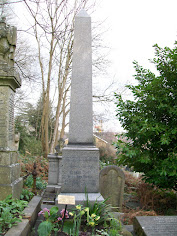This afternoon sojourn started exactly where a previous one ended, 'The Logs', on East Heath Road, Hampstead, thought to be the location of 'Appledore Towers', where 'the worst man in London', Charles Augustus Milverton, lived. In the story of the same name, Holmes and Watson attempted to burgle the property. The property was also being lived in by Marty Feldman (and his wife Loretta), when he appeared as Orville Sacker in ‘The Adventures of Sherlock Holmes Smarter Brother’ (1975). I took some more photos, as the light was poor by the time I reached here last time.
It was then a short walk to Hampstead Heath, where Mrs Warren’s husband was dumped after being kidnapped in Tottenham Court Road having been mistaken by the criminals for his mysterious lodger in ‘The Red Circle’.
Striding across the heath, after around half-an-hour’s walk, I found myself at my main destination for the afternoon, Highgate Cemetery. The cemetery in its original form – the north-western wooded area – opened in 1839, as part of a plan to provide seven large, modern cemeteries, now known as the "Magnificent Seven", around the outside of central London. The inner-city cemeteries, mostly the graveyards attached to individual churches, had long been unable to cope with the number of burials and were seen as a hazard to health and an undignified way to treat the dead. The initial design was by architect and entrepreneur Stephen Geary.
The cemetery is in two parts – East and West, and it was to the latter that I made my way first, having paid the entrance fee. After around 45 minutes searching across muddy pathways, as it did not appear on their ‘Notable Graves’ map, I found the grave that I was looking for, Adam Worth, who was originally buried in a pauper’s grave under the alias – Henry Judson Raymond. Worth was a Victorian Criminal, who stole Thomas Gainsborough's recently rediscovered painting of Georgiana Cavendish, Duchess of Devonshire from a London gallery of Thomas Agnew & Sons with the help of two associates. He is considered by scholars of Conan Doyle to be the basis of nemesis of Sherlock Holmes, Professor James Moriarty. His headstone even calls him "The Napoleon of Crime", Moriarty’s soubriquet.
On my way back to the gate, I passed graves for Beryl Bainbridge and David Devant, a magician, born David Wighton in Highgate, London, the son of a Scottish landscape artist, James Wighton. Taking the stage name Devant early in his career, he became a member of Maskelyne & Cook company which was acknowledged as the showcase for the age's premier magicians and performed regularly at the Egyptian Hall, Piccadilly, London. Being a student of the history of magic, I understood his importance (and his name also brought back memories of my student days when I saw a group called ‘David Devant and his Spirit Wife’ play live).
It was then over to the East Cemetery, with the cemetery’s most famous resident, Karl Marx, German Philosopher, Socialist, Economist and Revolutionary, passing the simpler memorial to author Douglas Adams, creator of ‘The Hitchhikers Guide to the Galaxy’.
A brief detour brought me to the grave and monument of Mary Ann Evans, who wrote as George Eliot, and that of Roger Lloyd Pack, 'Only Fools and Horses' Trigger (who also appeared in ‘Murder Rooms: The Photographer’s Chair’).
It was then onto two graves with clearer Sherlockian connections – Sir Ralph Richardson who played Watson in a 1950’s radio series opposite John Gielgud, and Tim Pigott-Smith who played Holmes in a 1986 BBC radio dramatisation of ‘The Valley of Fear’, Watson on Broadway in 1974/5 and wrote ‘The Baker Street Mysteries’ series of books.
It was then a short walk to the Gatehouse Public House in Highgate Village, which has its own pub theatre, for ‘The Return of Sherlock Holmes’, an adaptation of ‘The Empty House’. The play was a two-hander featuring Nigel Miles-Thomas and Michael Roy Andrew as Holmes and Watson respectively. The play lasted an hour and was enjoyable, save two unnecessary initial scenes, the first featuring Holmes, followed by one in which a mysterious letter is sent to Watson to interest him in the murder of Ronald Adair. However, certainly worth watching when it returns to the Edinburgh Fringe next summer.












No comments:
Post a Comment